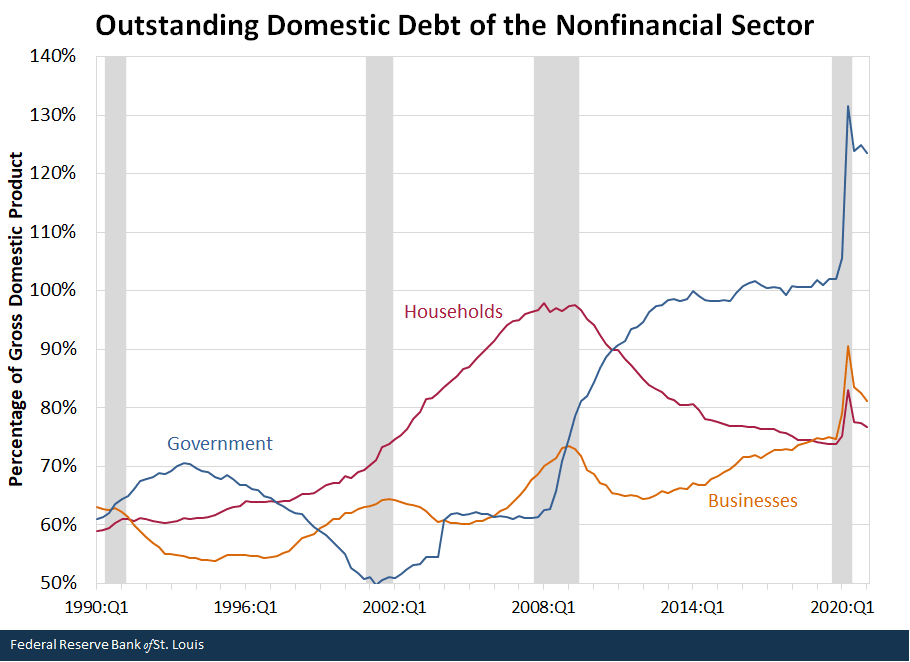OfTheCross
Veteran
We should be grateful 
Consumers tightened up and stopped over-extending themselves too.

Domestic Debt Before and After the COVID-19 Recession | St. Louis Fed
As with the financial sector, the great leveraging and post-2009 deleveraging of the household sector are clear in the figure. Also, similar to the financial sector, household debt increased in 2020 relative to its pre-pandemic trend. This increase is, however, dwarfed by the increases in nonfinancial business and government debt during that same period.
Nonfinancial business debt went from 74% of GDP in the fourth quarter of 2019 to 81% of GDP in the first quarter of 2021. There are several different factors that explain this increase. First, the Federal Reserve activated liquidity facilities (such as the Primary and Secondary Market Corporate Credit Facilities) that either directly or indirectly made it cheaper for businesses to borrow.
Second, a large part of the fiscal policy response to the pandemic recession involved subsidized loans to businesses to help them weather liquidity issues, most notably the Paycheck Protection Program.
Finally, the single largest increase as a percentage of GDP was that of government debt: from 102% of GDP before the pandemic to 124% in the first quarter of 2021. This increase was associated with the large fiscal response to the pandemic recession that was undertaken by the U.S. federal government, notably through the $2.2 trillion Coronavirus Aid, Relief and Economic Security (CARES) Act of March 2020 and the $1.9 trillion American Rescue Plan of March 2021. These were some of the largest fiscal packages ever deployed by the federal government, only comparable in magnitude to the American Recovery and Reinvestment Act of 2009 and the New Deal of the 1930s.
More than one year has passed since the end of the pandemic recession, and the outstanding domestic debt is still at much higher levels than before the pandemic. This increase was driven mostly by government and nonfinancial business debt. As with the Great Recession, there were also some interesting changes in the composition of this debt: Government debt, which was lower than household or business debt before 2011, has now firmly secured its place as the largest stock of nonfinancial debt. Additionally, nonfinancial business debt continued to exceed household debt, something that occurred in 2019 for the first time since the early 1990s, and which reflects not just the large increase in business debt as a consequence of the pandemic recession and associated fiscal policy response, but also the continued deleveraging of the U.S. household sector that began after the Great Recession.

Consumers tightened up and stopped over-extending themselves too.

Domestic Debt Before and After the COVID-19 Recession | St. Louis Fed
As with the financial sector, the great leveraging and post-2009 deleveraging of the household sector are clear in the figure. Also, similar to the financial sector, household debt increased in 2020 relative to its pre-pandemic trend. This increase is, however, dwarfed by the increases in nonfinancial business and government debt during that same period.
Nonfinancial business debt went from 74% of GDP in the fourth quarter of 2019 to 81% of GDP in the first quarter of 2021. There are several different factors that explain this increase. First, the Federal Reserve activated liquidity facilities (such as the Primary and Secondary Market Corporate Credit Facilities) that either directly or indirectly made it cheaper for businesses to borrow.
Second, a large part of the fiscal policy response to the pandemic recession involved subsidized loans to businesses to help them weather liquidity issues, most notably the Paycheck Protection Program.
Finally, the single largest increase as a percentage of GDP was that of government debt: from 102% of GDP before the pandemic to 124% in the first quarter of 2021. This increase was associated with the large fiscal response to the pandemic recession that was undertaken by the U.S. federal government, notably through the $2.2 trillion Coronavirus Aid, Relief and Economic Security (CARES) Act of March 2020 and the $1.9 trillion American Rescue Plan of March 2021. These were some of the largest fiscal packages ever deployed by the federal government, only comparable in magnitude to the American Recovery and Reinvestment Act of 2009 and the New Deal of the 1930s.
More than one year has passed since the end of the pandemic recession, and the outstanding domestic debt is still at much higher levels than before the pandemic. This increase was driven mostly by government and nonfinancial business debt. As with the Great Recession, there were also some interesting changes in the composition of this debt: Government debt, which was lower than household or business debt before 2011, has now firmly secured its place as the largest stock of nonfinancial debt. Additionally, nonfinancial business debt continued to exceed household debt, something that occurred in 2019 for the first time since the early 1990s, and which reflects not just the large increase in business debt as a consequence of the pandemic recession and associated fiscal policy response, but also the continued deleveraging of the U.S. household sector that began after the Great Recession.